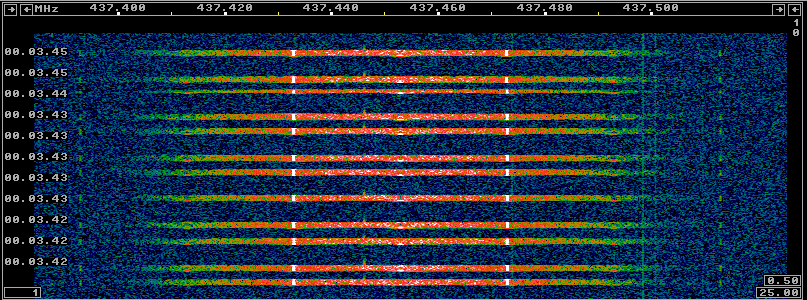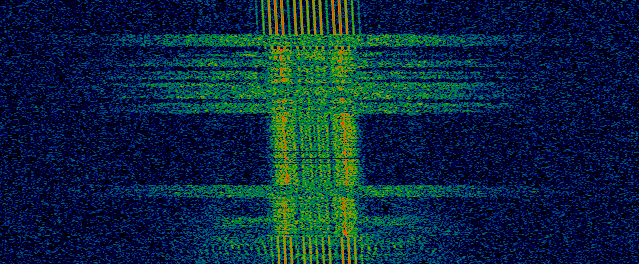HORYU-4 is a small satellite from Kyushu Institute of Technology (Japan) designed to test a high voltage solar array in space and observe the effects produced by the charge on the spacecraft due to the high voltage. It transmits telemetry on the 70cm and 13cm amateur bands. It has a CW beacon at 437.375MHz, a 1200baud AFSK telemetry downlink at 437.375MHz and a 100kbaud BPSK telemetry downlink at 2400.3MHz. The digital telemetry downlinks are only active over Japan and use a custom packet format. Here we take a brief look at the format of the CW telemetry.
Category: Space
Spacecraft and space science
Introducing gr-satellites
This post is to present my gr-satellites project. The goal of this project is to make a collection of GNUradio decoders for the telemetry of different satellites. The decoders support submitting telemetry in real time to the PE0SAT telemetry server. Another goal is that the decoders are as easy to use as possible, to try to make more people interested in receiving digital telemetry from satellites and collaborating in online telemetry submission.
The decoders can be used with the Gqrx SDR software, using its UDP audio streaming capabilities. This is the easiest way to use the decoders. It is also possible to use the GNUradio frontends in the companion project gr-frontends. These support several different SDR hardware, WAV and IQ recordings, and conventional receivers connected through a soundcard. They are design to be flexible and to allow its use in headless and automated receiving configurations.
The long-term goal of this project is to provide an alternative software chain to the UZ7HO soundmodem, AGW packet engine and DK3WN telemetry forwarder. The use of GNUradio makes these decoders more configurable and flexible and eases programming decoders for non-AX.25 satellites, which usually employ strong forward error correction.
Currently, the satellites supported by gr-satellites are 3CAT-2, AAUSAT-4 and GOMX-3. I plan to continue adding support for more satellites in the future.
Telemetry format of 3CAT-2
The team from the NanoSat Lab in Universidad Politècnica de Catalunya have published a telemetry analyser for 3CAT-2. This analyser is designed to connect to a TCP server and get the AX.25 frames in KISS format.
The telemetry format is rather simple, as one can see by looking at the PrintBeacon() function in 3cat2_telemetry.c. As I imagined, the contents of each beacon are just the numerical values of several telemetry channels written in ASCII. For example:
3 7781 0245 07 06 1 0 3.5e-01 2.5e-01 1.6e-01 6.8e-09 1.2e-09 1.8e-08
All the fields are separated by a space, except the 5th and 6th fields, which are separated by a tab. The content of the first 7 fields is as follows:
- Mode. Possible values: 1 survival mode, 2 sun-safe mode, 3 nominal mode, 4 TX communication incoming (data downlink), 5 RX communications (command uplink), 6 and 7 payload mode.
- Battery voltage in mV. In the example 7.781V.
- Current consumption in mA. In the example 245mA.
- EPS temperature (probably in ºC). In the example 7ºC.
- Antenna temperature (probably in ºC). In the example 6ºC.
- Status of the ADCS system. 0 means detumbling enabled. 1 means SS-nominal.
- Control flag of the ADCS routine. Possible values: 0 automatic, 1 manual
The next 3 fields are floating point numbers. If detumbling is enabled, they correspond to magnetomer values in nT for the axes X, Y and Z respectively. If detumbling is not enabled, they correspond to the sun vector, axes X, Y and Z.
The last 3 fields correspond to the control voltages for axes X, Y and Z, regardless of whether detumbling is enabled or not.
Of course, the telemetry format is so easy that it can even be parsed with a “one-line” awk script:
strings sats/3cat2-20160824-pe0sat.kiss | awk '{if ($1==1) printf "Survival"; if ($1==2) printf "Sun-safe"; if ($1==3) printf "Nominal"; if ($1==4) printf "TX"; if ($1==5) printf "RX"; if ($1>=6) printf "Payload"; printf " %.2fV %dmA EPS: %2dºC Ant: %2dºC ", $2*1e-3, $3, $4, $5; if ($7==0) {printf "ADCS auto "} else {printf "ADCS manual "}; if ($6==0) {printf "Detumbling (%f,%f,$f) nT", $8, $9, $10} else {printf "SS-nominal Sun: (%.2f,%.2f,%.2f)", $8, $9, $10}; printf " Control (%.1e,%.1e,%.1e)V\n", $11, $12, $13}'
which shows the following output:
Nominal 8.26V 233mA EPS: 4ºC Ant: 8ºC ADCS auto SS-nominal Sun: (0.49,0.42,1.00) Control (6.9e-09,1.7e-09,1.7e-08)V Nominal 8.28V 221mA EPS: 5ºC Ant: 8ºC ADCS auto SS-nominal Sun: (0.16,0.87,0.57) Control (6.7e-09,1.4e-09,1.7e-08)V Nominal 8.29V 245mA EPS: 5ºC Ant: 8ºC ADCS auto SS-nominal Sun: (0.26,0.96,0.46) Control (6.7e-09,1.4e-09,1.7e-08)V Nominal 8.30V 257mA EPS: 5ºC Ant: 8ºC ADCS auto SS-nominal Sun: (0.62,0.78,0.42) Control (6.7e-09,1.4e-09,1.7e-08)V Nominal 8.30V 257mA EPS: 5ºC Ant: 9ºC ADCS auto SS-nominal Sun: (0.64,0.72,0.49) Control (6.7e-09,1.4e-09,1.7e-08)V Nominal 8.30V 245mA EPS: 5ºC Ant: 9ºC ADCS auto SS-nominal Sun: (0.64,0.66,0.59) Control (6.8e-09,1.5e-09,1.7e-08)V Nominal 8.30V 245mA EPS: 5ºC Ant: 9ºC ADCS auto SS-nominal Sun: (0.60,0.60,0.71) Control (6.8e-09,1.5e-09,1.7e-08)V Nominal 8.30V 245mA EPS: 5ºC Ant: 9ºC ADCS auto SS-nominal Sun: (0.54,0.54,0.86) Control (6.8e-09,1.6e-09,1.7e-08)V Nominal 8.29V 245mA EPS: 5ºC Ant: 10ºC ADCS auto SS-nominal Sun: (0.45,0.49,1.00) Control (6.9e-09,1.7e-09,1.7e-08)V Nominal 8.28V 245mA EPS: 5ºC Ant: 10ºC ADCS auto SS-nominal Sun: (0.32,0.44,1.00) Control (6.9e-09,1.7e-09,1.7e-08)V
The KISS file in question was obtained from the recording on 24/08/2016 at 10:54 by PE0SAT that I mentioned at the end of a previous post.
Many thanks to Juan Fran Muñoz and the rest of the NanoSat Lab team for publishing the telemetry analyser and sharing details about the satellite and the operations.
How hard is it to decode 3CAT-2?
In a previous post, I looked at the telemetry packets transmitted by the satellite 3CAT-2. This satellite transmits 9600bps AX.25 BPSK packets in the Amateur 2m band. As far as I know, it is the only satellite that transmits fast BPSK without any form of forward error correction. LilacSat-2 uses a concatenated code with a (7, 1/2) convolutional inner code and a (255, 223) Reed-Solomon outer code. The remaining BPSK satellites transmit at 1200bps, either using AX.25 without FEC (the QB50p satellites, for instance), or with strong FEC (Funcube, for example). Therefore, I remark that 3CAT-2’s packets will be a bit difficult to decode without errors. But how difficult? Here I look at how to use the theory to calculate this, without resorting to simulations.
Decoding packets from 3CAT2
On 15th August, a Chinese CZ-2D rocket launched three satellites from Juiuquan (Mongolia). The main payload was the Chinese satellite QSS, designed to do some experiments in quantum communications and entanglement. As anything that has the word quantum on it, this satellite even made it to the mainstream news in Spain. The rocket also launched Lixing 1, another Chinese satellite which will research the upper atmosphere, and 3CAT2, from the Universidad Politècnica de Catalunya (Spain).
3CAT2’s main payload is a GNSS reflectrometer designed to measure the altitude of the Earth and map the oceans. This means that it uses reflections of satellite navigation signals off the surface of the earth and sea to perform mapping. It will mainly use the L1 and L2 signals from GPS, but it can also work with Galileo, GLONASS and BeiDou signals. It also carries a prototype of a magnetometer designed for the eLISA project. This project consists in setting up a laser interferometer in space to observe gravity waves. It is roughly the same as the Earth-based LIGO, that recently confirmed the first detections of gravity waves. However, since eLISA will be in space, its laser arms will much longer than LIGO’s. This permits to study much lower frequencies than it’s possible Earth-based interferometers.
3CAT2 has a downlink in the Amateur 2m band, at 145.970MHz, and transmits 9600bps BPSK. It also has a faster BPSK downlink in the S-band, presumably at 2401MHz (inside the Amateur 13cm band). The days following 3CAT2’s launch I tried to receive its VHF signal, without any luck. I have been in contact with other Amateurs who also listened and didn’t hear anything.
This morning, I’ve received email from Scott K4KDR telling me that he has heard the satellite for the first time and he has managed to do a recording, but he is unable to decode the data.
We where unsure about which encoding that 3CAT2 is using. It could be AX.25, or some custom protocol using FEC. As far as I know, the only other satellite that transmits 9k6 BPSK in the Amateur bands is LilacSat-2, which uses strong FEC. Nevertheless, I’ve taken a good look at Scott’s recording and I’ve been able to decode one packet. This is, as far as I’m aware, the first decoding of 3CAT2 by an Amateur operator.
Trying to decode data from ÑuSat
Last Monday, a Chinese CZ-4B rocket launched the Chinese Earth observation satellite ZY-3 and the Argentinian satellites ÑuSat-1 and 2. These two satellites are the first of the Aleph-1 constellation of Earth observation satellites. ÑuSat-1 carries LUSEX, an Amateur payload which consists of a U/V linear transponder. Also, the two ÑuSat satellites transmit backup telemetry in the 70cm Amateur band, as one can see in the IARU frequency coordination application. In fact, the latest news is that ÑuSat-1 transmits telemetry on 436.445MHz and ÑuSat-2 uses 437.445MHz. According to the public announcements, the telemetry was supposed to be 9200 baud or 19200 baud. However, some people have noticed that, on the contrary, it is 40 kbaud. Although the modulation and coding specifications are not public, I’ve taken a look at an IQ recording of ÑuSat-2 by Mike DK3WN to see if I can decode anything. Here are my findings.
GOMX-3 data download
This weekend, Mike DK3WN caught GOMX-3 downloading a good amount of data. See his post here. This data consists mainly of the satellite retransmitting a lot of beacons that were generated during the last 16 hours or so.
GomSpace has recently released a complete parser for GOMX-3 beacons of type 1 0 (these are the beacons that contain ADS-B data). I have already incorporated this code into my gr-ax100 fork.
The binary data in KISS format (almost 250KB) and the parsed beacon data received during this data download is in gist. Probably the most interesting thing is the ADS-B data. Below you can see all the aircraft on the map. Clicking on any of them will show the details for that aircraft.
Since the orbit of GOMX-3 has an inclination of 51.6º, the satellite doesn’t usually detect aircraft above 55ºN or below 55ºS. GomSpace has an image which shows lots of flights received with GOMX-3. There, the major air routes and hubs are apparent.
LilacSat-2 subaudio telemetry
Yesterday, the FM repeater on the Amateur satellite LilacSat-2 was active. I’ve talked about LilacSat-2 before, but so far I hadn’t made any recordings containing subaudio telemetry. While contacting several Spanish stations (EA5TT, EA1JM and EA1IW) throughout the pass, I made an IQ recording to analyse the telemetry later. Here I take a look at the telemetry format and the decoded data.
Decoding packets from GOMX-3: CSP packets
A few days ago, I talked about the modulation and coding used by the satellite GOMX-3. Here, I will look at the contents of the CSP packets transmitted by this satellite.
Decoding packets from GOMX-3: modulation and coding
Recently, Mike DK3WN pointed me to some decoder software for the satellite GOMX-3. This satellite is a 3U cubesat from GomSpace and transmits in the 70cm Amateur band. It has an ADS-B receiver on board, as well as an L-band SDR. As far as I know, no Amateur has decoded packets from this satellite previously, and Mike had some problems running the decoder software. I have taken a look at the software and tried my best to decode some packets from GOMX-3. So far, I have been able to do Reed-Solomon decoding and get CSP packets. However, I don’t have the precise details for the beacon format yet. Here, I describe all of my findings.


